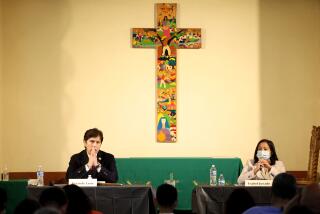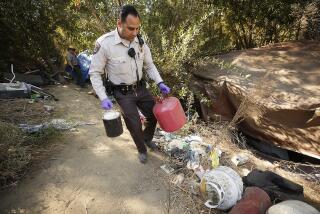Union Seeks Voter OK for More Police : Ballot: Measure would require San Diego to nearly double the size of the force by the end of the decade.
Coming off a record year for homicides and faced with a shortage of officers, the San Diego Police Departmentâs labor union is proposing to place a measure on the November ballot that would force the city to nearly double the size of the force by the end of the decade.
The ballot proposal would require that the first wave of new officers be hired by 1993 and that more be added each year except one until 1999. All told, the officers would cost the city $110 million, according to those familiar with the proposal, which is to be unveiled today.
The measure does not account for how the new positions would be financed, other than to require the city to come up with the money however it can. Since the proposal contains no provision for a tax increase, it can be approved with a simple majority rather than a two-thirds vote.
The San Diego Police Officers Assn., which represents most of the cityâs 1,850 officers, is scheduled to discuss the details at a news conference this morning, at which City Councilmen Tom Behr, Bob Filner and Ron Roberts are expected to lend their support.
Five of the councilâs nine votes are necessary to directly place the measure on the ballot. Otherwise, police union officials must obtain 82,549 valid signatures of registered voters in the city. Other council members interviewed Tuesday said they either had not seen the proposal or did not support it.
If approved, the ballot measure would serve as an amendment to the City Charter, mandating the council to hire enough new officers by 1999 so that San Diego has a ratio of 2.4 officers per 1,000 residents.
San Diego now has 1.62 officers per 1,000, ranking ninth out the 10 most populous cities for the past three years.
Top-level city administrators, who asked not to be named, said they have serious concerns about the proposal. Without a tax increase, they said, it would have a severe effect on the city budget.
For the past decade, various City Council members have promised to increase the police ratio to at least 2 per 1,000. Union officials say that even more officers are needed in the wake of the cityâs 1991 homicide rate, its highest ever.
They declined to discuss the proposal until todayâs news conference. But the move for a ballot proposal began in November, when union representatives began meeting to determine whether to lobby city officials or go to the voters.
At the time, Harry O. Eastus, president of the police association, called a move to get more officers on the street âour No. 1 priority. Doing with what we have is like rearranging the chairs on the Titanic.â
The police union developed a formula that assumes the cityâs population will grow by 40,000 per year, reaching 1.37 million by 1999. By those calculations, the department will need to employ 3,288 sworn officers, 78% more than its existing force.
Mayor Maureen OâConnor caustically dismissed the proposed initiative Tuesday as a âtotally irresponsibleâ plan that would force Draconian cutbacks, if not outright elimination, of many city programs and services.
âThe only way youâd have enough money to do this would be to cut the Fire Department, the parks, the after-school programs and plenty else--everything but police,â OâConnor said. âWeâre not going to end up with a city with police but nothing else.â
Similarly, Councilman John Hartley questioned the advisability of âlocking ourselves into a formula with a blank check attachedâ without knowing the economic realities that will govern the cityâs future budgets.
Hartley also suggested that the officer-per-resident ratio comparison between San Diego and other cities might be skewed by San Diegoâs use of civilians for jobs handled by sworn officers elsewhere.
âIâm all for more police, but I donât think we can commit to specific figures years in advance,â Hartley said. âPlus, we need to make sure that the comparisons being made are valid.â
Roberts, however, argued that future revenue increases from new fees and population growth could help fund the hiring of more officers without severe harm to existing programs.
For example, if voters were to repeal the cityâs so-called Peopleâs Ordinance, which guarantees free garbage pickup to city homeowners--a decades-old financial luxury that some city officials argue cannot be preserved amid the economic constraints of the 1990s--millions of extra dollars could be generated annually for the city treasury.
Pointing out that the City Charter already identifies law enforcement as San Diegoâs top budgetary priority, Roberts added that the proposed POA initiative would simply âbetter define exactly what priority meansâ by establishing numerical targets for police staffing levels.
Councilman George Stevens, who strongly advocated police staff increases during last fallâs council campaign, said Tuesday that he had not yet seen the POAâs proposal, but spoke favorably about its goals.
âI definitely want more police officers per thousandâ residents, Stevens said. âIâd like to get up to two per thousand in the next budget if possible.â
The possibility exists that the police union initiative may have a competing measure on the ballot in November.
On Monday, the managed-growth group Prevent Los Angelization Now! announced that it is collecting signatures for an initiative that would ensure that new development does not lower the ratio of police to population.
The initiative also mandates that developers pay for ânew and existing police facilities and servicesâ but does not specify how those costs would be determined.
More to Read
Sign up for Essential California
The most important California stories and recommendations in your inbox every morning.
You may occasionally receive promotional content from the Los Angeles Times.










